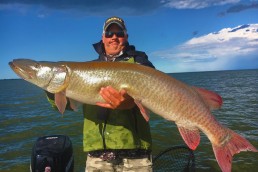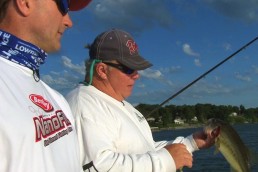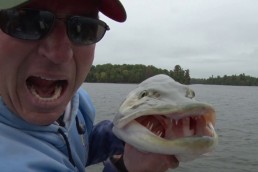Make this your Best Muskie Year Yet
SHARE THIS POST
I always enjoy the winter months, as the visiting sport shows and muskie clubs can be therapeutic. It’s a great way to scratch that muskie-fishing itch. I love sharing stories among fellow muskie hunters, and believe me, I hear some incredible stories and see unbelievable photos. I also get to share laughs and answer many questions. After last year’s sports show season and a summer’s worth of emails, I’ve started seeing a pattern of common questions.
Here are my answers to three of the most common questions, and comments, that I receive every year that might help you catch more muskies this season.
“We go on a trip to ‘Lake X’ every year. It has big muskies but we just can’t catch one.”
This is by far the most common question (comment). And even though I have no way of observing a fisherman’s own skills from a conversation, it doesn’t take long for the most common question to be asked. The reason you’re not having the results you’d like is because you’re fishing the water at the wrong time. We’re all creatures of habit, and annual fishing trips become rituals. After all, no matter how poor the muskie fishing can be we are with friends or family, and have a great time. After a couple months it’s easy to forget about the fact you didn’t encounter any big muskies and then make plans for the same resort on the same water next year at the exact same time. More than likely, your results are going to be the same. Sure, someone in camp may have caught a giant over the years at the same place and period, but if this lake has big ones and you aren’t seeing them you need to switch your trip up a bit. The most common error is going too early.
In the North, if you’re going fishing near the opener with some friends that are really there to catch walleyes, I don’t care where you are, as most likely the muskie fishing is going to be tough. You then have to hope for a warming trend with stable conditions to have any chance of scoring big. But if you love the resort and lake, simply try going several weeks later. Maybe try late summer or early fall. Don’t worry—you’ll find the muskies. If they are there you’ll catch them. Trust your skills, and if that week is the only time when everyone can fish together then you better find a new location.
Are you enjoying this post?
You can be among the first to get the latest info on where to go, what to use and how to use it!
“How much time to spend on a spot?”
This may seem like a simple question, but it’s one of the most difficult to answer. The obvious consideration is to know how large this spot is. Certainly, a larger location requires more time to fish. Beside the size of the area, you also have to consider both the conditions and how the muskies are responding. If conditions are cloudy, warm and stable, generally, I’ll fish faster and don’t spend too much time on a particular spot. I anticipate there’s a pack of active muskies, and by fishing fast and to multiple spots, you then increase your odds at finding the more active fish. On the other hand, if conditions are sunny with no wind or humidity the muskies most likely are inactive and holding tight to available cover. That requires making more casts on any given spot, so you will then be forced to spend more time on that individual location.
Muskie activity is another important consideration. If you fish several spots and don’t have any muskies following or striking, I will try different areas, but I’ll also make it a point to spend more time on each spot but instead make several “closely spaced” casts to elicit a strike. If the fish start following and biting you can then assume you’ve entered a window of increased activity and can then start fishing faster and spend less time on that given spot. By considering both weather and muskies activity, you can better gauge how long to spend on an area. Overall, I would suggest when it doubt, spend less time on a spot then you would think. I rarely spend more than 20 minutes on one unless conditions or the situation dictates it.
“What’s one thing you recommend to help me catch more muskies?”
This question is common. Understand, unless I can see your muskie-fishing skills, it’s a little more difficult to provide a realistic answer. However, teaching muskie-fishing schools for 30 years and watching my students fish there are two things that can help the majority of anglers struggling to catch more. Working on your figure eight is almost a guarantee to catch more. You need to make a large figure eight with your lure every single cast. This doesn’t mean when you feel like it or only when you see a muskie follow you. This is also where a longer rod makes a big difference. I use an 8-foot 6-inch rod or longer. I use the Shimano Compre rod for most of my muskie-fishing applications. Longer rods allow me to make large turns and manipulate the lure during the figure eight. Focus on making big turns during the figure eight and perform it every single cast. Soon, it will become second nature. When a muskie does follow you’ll then execute more under pressure and catch them. If you can catch one more on a figure eight every trip, just think how your catches will increase by the end of the year? Boat control is another area that can pay off. No matter how well you manipulate any lure with figure eight, if you can’t hold your boat in the right spot you won’t catch them. Try not to be too close to the cover. If you look down and can see weeds below the boat, most of the time you’re just too close. I’d prefer to be too far from the cover than too close. That way you won’t miss any points, turns or extensions. When approaching every spot, consider how best to fish that area and try to work into the wind whenever possible. This will ensure you’re making precise casts to the right area and not spook any fish. The result will be more muskies in the boat.
MWO
SHARE THIS POST
Did you enjoy this post?
You can be among the first to get the latest info on where to go, what to use and how to use it!
Jim Saric
Jim Saric is a Legendary Angler in the Freshwater Fishing Hall of Fame, the host and executive producer of The Musky Hunter television series, editor at large of Musky Hunter magazine, a seven-time muskie tournament winner, and a contributing writer for numerous other publications.



